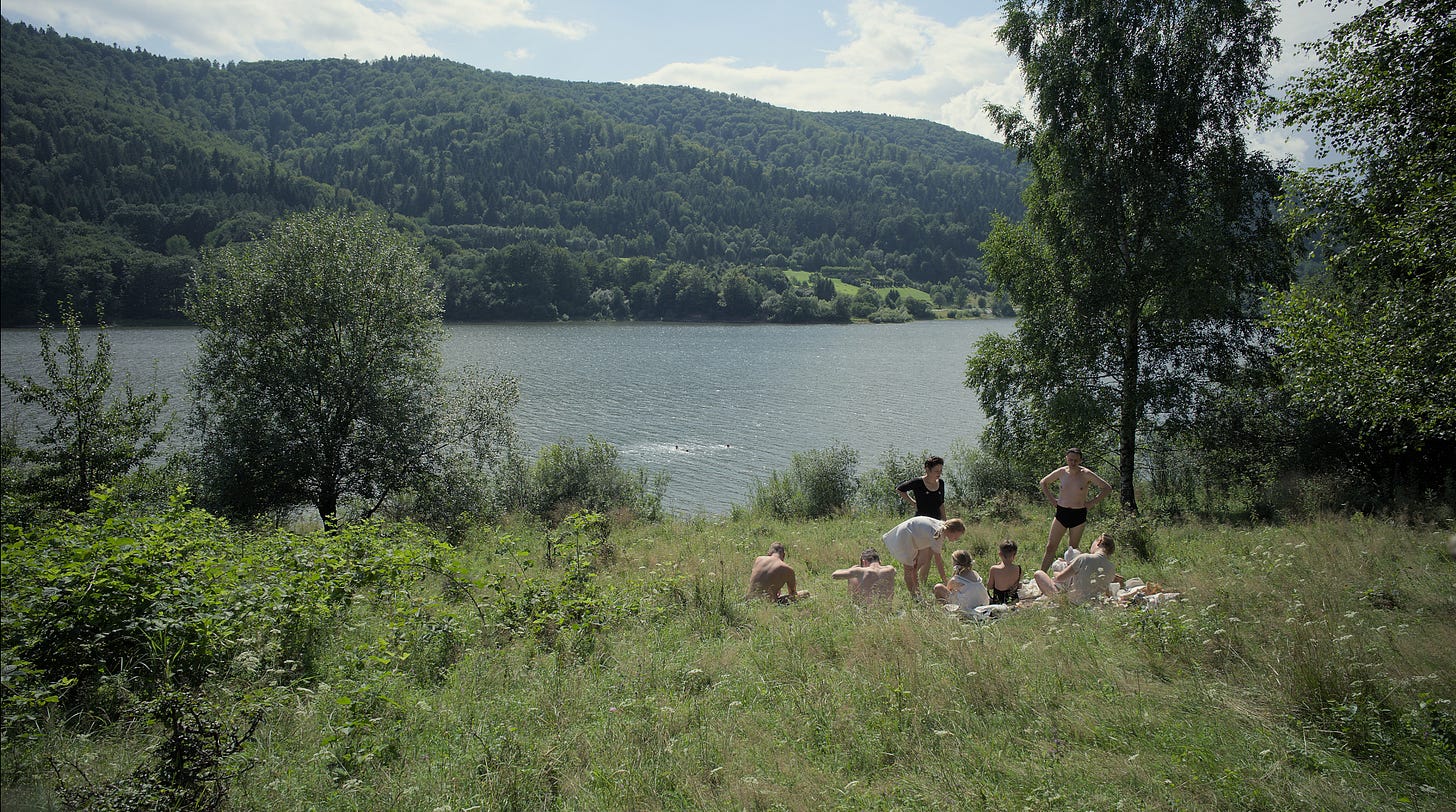There’s a void at the center of Jonathan Glazer’s Holocaust drama The Zone of Interest and not the envelopingly inky one that the characters walk into whenever traversing dimly lit hallways or stairwells. It is, perversely, a lack of the blackest humor, the dearth of the darkest of funny bones, for this is a movie composed almost entirely of sight gags stemming from the sickest of jokes: How do you build an idyllic life when your next-door neighbor is Auschwitz?
The result is depraved in its way, at once a po-faced drama of ignorant domestic bliss and a dryly details-oriented workplace sitcom from Hell, a Kubrick/Tarkovsky acolyte fusing The Boy in the Striped Pyjamas with Heil Honey I’m Home!
Yet the movie doesn’t offend; it’s too solemnly risk-averse for that. Glazer takes grandiose liberties with the fictionalized source material — Martin Amis’s novel of the same name from 2014 — interestingly by hewing closer to fact. Christian Friedel and Sandra Hüller play the real-life Nazi commandant of Auschwitz, Rudolf Höss, and his housemaker wife, Hedwig, and much of the drama (Glazer also wrote the screenplay) is constructed from testimonies and corroborating documents stored at the Auschwitz Museum.
Whatever brownie points can be given for historical fidelity, however, must be judged against onscreen evidence, and this is a case where the aesthetic approach — typified by the brutality-eliding imagery of cinematographer Łukasz Żal, the show-offily suggestive sound design of Johnnie Burn and his team, the doom-droney score by composer Mica Levi, and Glazer’s (tomb)stone-faced austerity — mainly service the same monotonous note. Said note is best described as “feature-length subliminal primal scream with dry-vomit climactic flourish” (the latter a light ape of the purgative finale of Joshua Oppenheimer’s The Act of Killing). Workin’ for the SS makes you retch, whodathunk? Though the oppressive milieu, even though shot on or near the site of actual atrocity, never feels less than contrived, conjured from the ether of the A24 house style, all the action captured by an abundance of hidden cameras, a fanatical method that Glazer has sincerely likened to “Big Brother in the Nazi house.”
That there’s a pretty brazen, patently ludicrous, and admittedly hell-yeah-I-want-to-see-that! mission statement. But what’s missing here is any deeply felt sense of how the absurd and the unspeakable co-mingle. See, for example, the seemingly single shot in Polanski’s The Pianist in which Nazi hoodlums toss a wheelchair-bound man from a balcony, a sentient human being becoming a bone-broken rag doll quicker than the rational mind can process so that something between a cackle and a howl gets throat-stuck.
Everything in The Zone of Interest is, by contrast, processible, impossible to misunderstand or misinterpret, and lifeless as a result. The guard tower and smokestacks of Auschwitz peek up over the Höss’s garden wall like fairy-tale behemoths. (Father Höss even reads his kids Hansel & Gretel at one point to hammer home the fable-like parallels.) A train carrying the latest “loads” of undesirables to be exterminated is indicated mainly by engine steam rising above the tree-lined horizon, a recurring visual so swaggeringly painterly it sticks in the craw. Ashy human remains flit through the air and pollute the nearby river, soiling clothing and flesh. The unholy-water imagery is a pale shadow of a similar sequence from Spielberg’s War of the Worlds, much as a subplot featuring a young resistance fighter gathering apples at nighttime (scenes shot in photonegative Sicario-vision) is a shallow reconceptualization of Schindler’s List’s little girl in the red coat.
Glazer isn’t some hacky non-talent, of course, so certain of his ideas, like the long walk Rudolf takes through an underground bunker to a hidden room where he washes his wandering cock post-coitus, do land in the banality-of-evil-resonating way intended. It’s telling, though, that the most effective sequence comes very close to the end as the commandant appears to leap through time to the present day. It’s an episode a friend of mine likened to that section of Alan Moore’s From Hell in which Jack the Ripper has a mid-murder premonitory vision of our modern era, and the tenor of the film suddenly changes into something Wiseman-like, documenting the ins and outs of maintaining a sacred space of remembrance while conveying the overarching thesis about the absence/omission of the victimized in truly productive and poetic ways. It isn’t the movie we’ve been watching to that point, sadly, the one that reinforces the obvious via stultifying formalism, the Final Solution as filtered through the “One Perfect Shot” processor.


